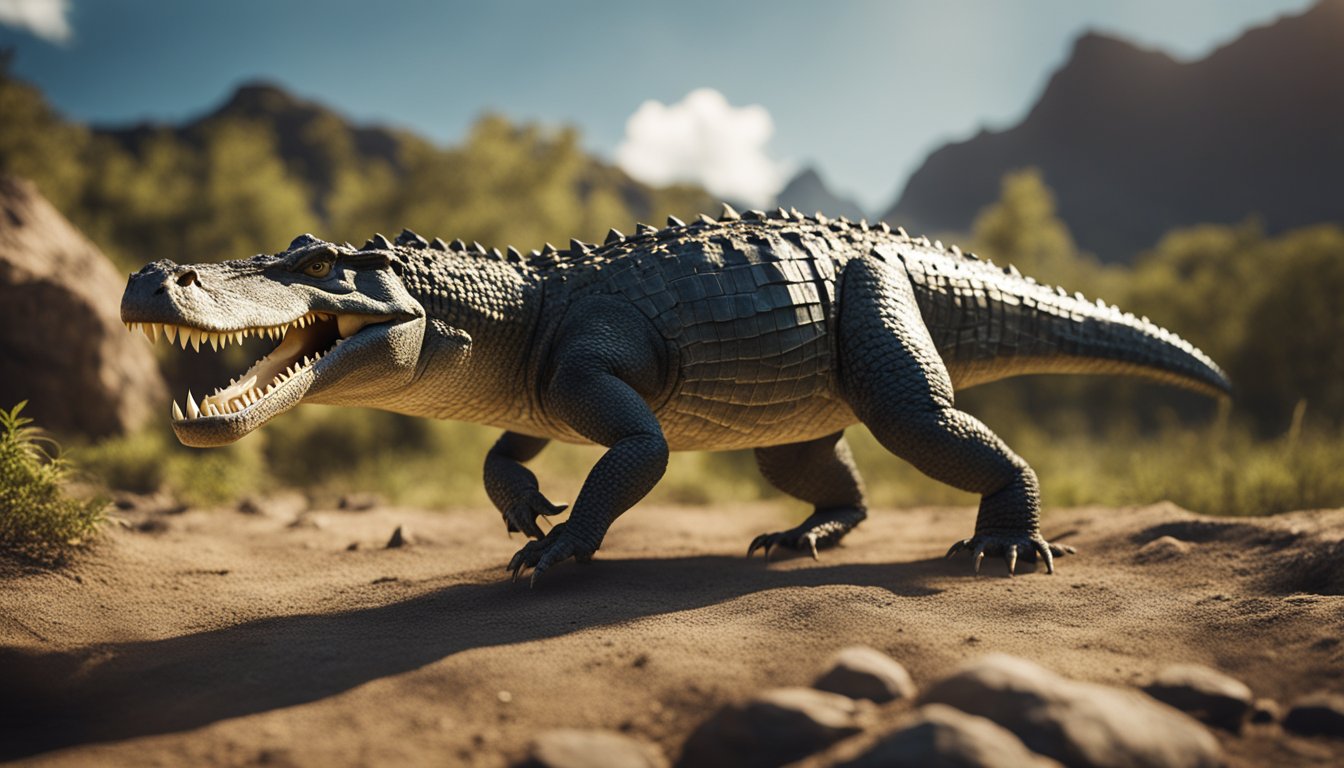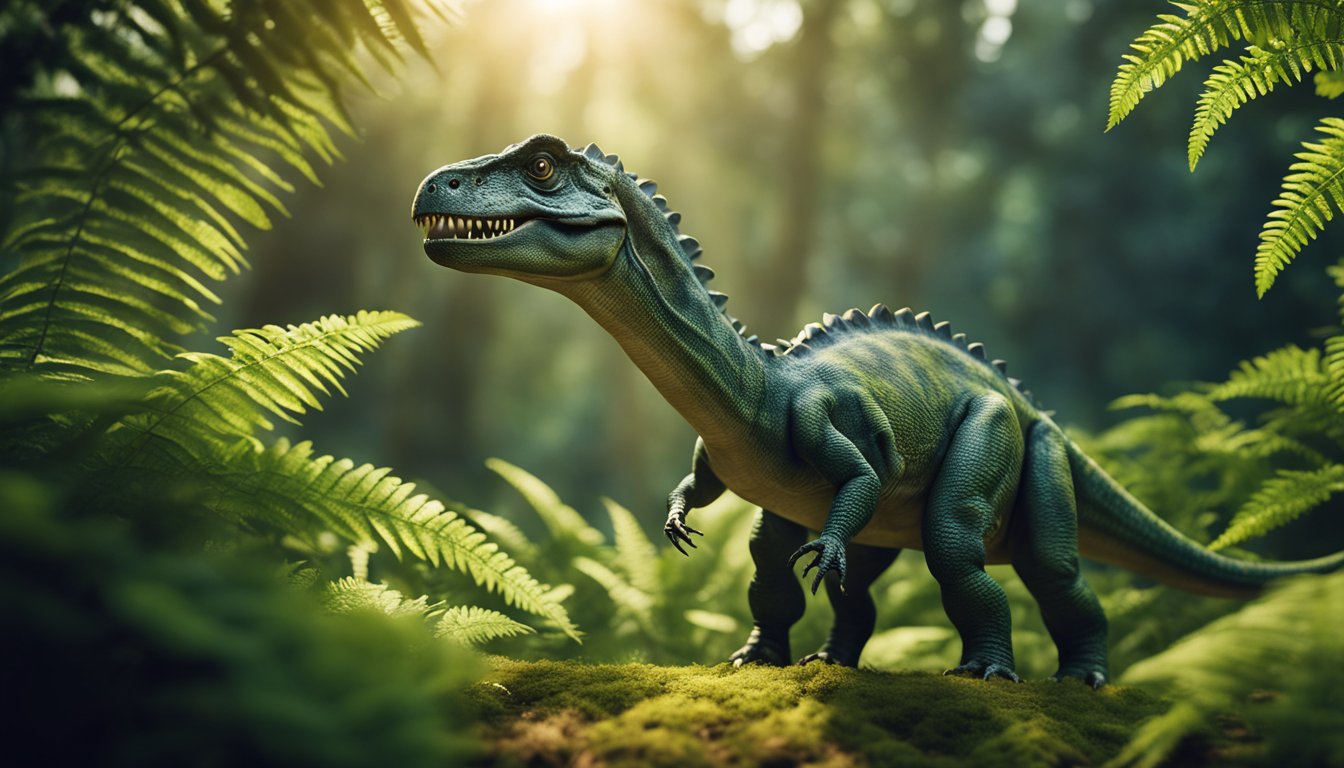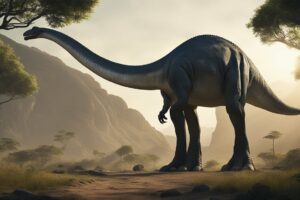Postosuchus was a fierce predator that roamed the earth long before the age of the dinosaurs.
This crocodile-like creature lived during the Triassic Period, which spanned from 252 to 201 million years ago, and was one of the top predators of its time.
Postosuchus was a member of the Rauisuchia group, which included a variety of carnivorous reptiles that dominated the land before the rise of the dinosaurs.

Postosuchus was an apex predator, meaning it was at the top of the food chain in its ecosystem.
It had a powerful build, with a long, muscular tail and sharp teeth designed to rip through flesh.
Its name means “post crocodile” because it was similar in appearance to modern-day crocodiles, but it was not actually related to them.
In fact, Postosuchus was more closely related to birds and dinosaurs than to crocodiles.
Despite its fearsome appearance, Postosuchus eventually went extinct, paving the way for the rise of the dinosaurs.
Unveiling the Postosuchus
Postosuchus was a crocodile-like predator that lived on Earth long before the dinosaurs.
It was a fearsome creature that roamed the land during the Late Triassic period, around 230 to 220 million years ago.
Physical Characteristics
Postosuchus was a large reptile that could grow up to 15 feet long and 8 feet high.
It had a long tail that helped it balance its weight and two powerful legs that allowed it to move quickly.
Postosuchus was both bipedal and quadrupedal, meaning it could walk on two or four legs depending on the situation.
Postosuchus had a large, wide skull with sharp, serrated teeth that were perfect for cutting flesh.
Its narrow snout had many large, dagger-like teeth that enabled it to catch and kill prey.
Postosuchus had a unique body shape, with a broad chest and a narrow waist that gave it a streamlined appearance.
Habitat and Distribution
Postosuchus fossils have been found in North America, specifically in Texas and Arizona.
It is believed that Postosuchus lived in forests and near rivers, where it could hunt for prey.
Fossils of Postosuchus have been found in rocks that were deposited in a range of environments, including floodplains, lakes, and river channels.
These fossils have provided scientists with important information about the life and behavior of Postosuchus.
Fun Fact: Postosuchus was not a dinosaur, but it lived alongside them during the Late Triassic period.
Lifestyle of a Prehistoric Predator

Postosuchus was a prehistoric predator that lived before the dinosaurs.
This carnivorous reptile was an apex predator, meaning that it was at the top of the food chain in its ecosystem.
Postosuchus was an ambush predator, which means that it would hide and wait for its prey to come close before attacking.
Diet and Hunting Techniques
Postosuchus was a carnivore, which means that it ate meat. Its diet consisted of small to medium-sized prey, such as other reptiles and early mammals.
Postosuchus had a powerful jaw and sharp teeth that it used to tear apart its prey.
To hunt, Postosuchus would hide in the vegetation and wait for its prey to come close.
Once it had an opportunity, Postosuchus would pounce on its prey with incredible speed and force.
Its strong legs and muscular body allowed it to take down prey much larger than itself.
Postosuchus’ Role in the Ecosystem
Postosuchus was an important predator in its ecosystem. As an apex predator, it helped to control the population of other animals in its environment.
By hunting and killing other reptiles and mammals, Postosuchus helped to prevent overpopulation and maintain a healthy balance in the ecosystem.
Postosuchus also played a role in the evolution of other animals.
Its predatory behavior may have influenced the evolution of other reptiles, such as crocodiles and dinosaurs.
By studying Postosuchus, scientists can learn more about the evolution of these animals and how they became the predators we know today.
Fun Fact: Postosuchus was not actually a dinosaur, but it lived alongside them during the Late Triassic period.
Postosuchus and Dinosaurs

Postosuchus was a fierce predator that roamed the earth millions of years before the age of the dinosaurs.
Despite being a close relative of crocodiles, Postosuchus was not a dinosaur, but rather a member of the archosaur family, which also includes dinosaurs, pterosaurs, and other extinct reptiles.
Coexistence and Competition
During the Late Triassic period, when Postosuchus lived, the world was a very different place.
Dinosaurs were just beginning to emerge as the dominant land animals, and Postosuchus was one of their main competitors.
While dinosaurs were evolving to become faster and more agile, Postosuchus was adapting to become a more efficient predator, with sharp teeth and powerful jaws.
Despite their fierce competition, Postosuchus and dinosaurs managed to coexist for millions of years.
Scientists believe that Postosuchus may have hunted smaller dinosaurs, while larger dinosaurs may have preyed on Postosuchus.
This dynamic relationship between predator and prey helped to shape the evolution of both groups.
Comparative Anatomy
One of the most fascinating aspects of Postosuchus is its anatomy.
While it shares many features with crocodiles, it also has some unique adaptations that set it apart.
For example, Postosuchus had a more upright posture than crocodiles, which allowed it to move more quickly and efficiently on land.
It also had longer legs and a more streamlined body, which made it a more effective runner.
Compared to dinosaurs, Postosuchus had a shorter stride and a less flexible spine.
However, it was still a formidable predator, with sharp teeth and powerful jaws that could crush bone.
Its skull was also more robust than that of most dinosaurs, which suggests that it was well adapted to handle the stresses of hunting and feeding.
In conclusion, Postosuchus was a fascinating and important member of the archosaur family.
Its coexistence and competition with dinosaurs helped to shape the evolution of both groups, and its unique anatomy provides valuable insights into the biology of prehistoric reptiles.
Extinction and Legacy

The End of an Era
Postosuchus lived during the Late Triassic period, which was a time of great change in the Earth’s history.
During this period, the supercontinent Pangea was beginning to break apart, and the climate was becoming drier and more arid.
These changes had a significant impact on the flora and fauna of the time, and many species, including Postosuchus, went extinct.
The exact cause of Postosuchus’ extinction is not known, but it is believed to be due to a combination of factors, including competition from other predators and changes in the environment.
Despite its extinction, Postosuchus played an important role in the evolution of reptiles and mammals, and its legacy can still be seen today.
Postosuchus’ Impact on Science
Postosuchus was first discovered in 1922, and since then, it has been the subject of extensive research by paleontologists.
Its unique features, such as its crocodile-like ankle joint and its ability to walk on two legs, have provided valuable insights into the evolution of reptiles and the transition from quadrupedal to bipedal locomotion.
Postosuchus has also played an important role in the study of the Late Triassic period and the mass extinction that occurred at the end of it.
By studying the fossils of Postosuchus and other animals that lived during this time, paleontologists have been able to piece together a picture of what life was like during this period and how it was affected by environmental changes.
In conclusion, Postosuchus may have gone extinct millions of years ago, but its legacy lives on in the scientific community.
Its unique features and the insights they provide into the evolution of reptiles and the history of the Earth continue to fascinate and inspire scientists and the general public alike.
Frequently Asked Questions

What did Postosuchus eat during its time on Earth?
Postosuchus was a carnivore, meaning it ate meat. It is believed to have been an ambush predator that captured its prey by stealth and surprise.
Postosuchus would have hunted smaller animals, such as reptiles and amphibians, as well as other small dinosaurs.
It had sharp teeth that were perfect for tearing through flesh and holding onto prey.
How does the size of Postosuchus compare to modern-day animals?
Postosuchus was a large animal, growing up to 4.5 meters (15 feet) in length and weighing up to 250 kilograms (550 pounds).
Its size is comparable to that of a modern-day crocodile, but it had a much more robust build.
Its legs were positioned more vertically underneath its body, which gave it a more upright posture.
What are the distinctive features that differentiate Postosuchus from actual crocodiles?
While Postosuchus may have looked similar to a crocodile, it had several distinctive features that set it apart.
One of the most noticeable differences is that Postosuchus had a more upright posture due to its legs being positioned more vertically under its body.
Additionally, Postosuchus had a more robust build and a longer tail than a crocodile.
It also had a different ankle joint that would have made it less efficient at running.
How fast could a Postosuchus move, and what advantages did this speed give it?
Postosuchus was not a particularly fast animal. Its crocodile-like ankle joint discouraged fast running.
However, it was still a formidable predator due to its strength and sharp teeth.
Postosuchus was probably an ambush predator that captured its prey by stealth and surprise.
What evidence do we have to show that Postosuchus is not a dinosaur?
Postosuchus is often mistaken for a dinosaur, but it is actually part of a group of reptiles called rauisuchians.
While rauisuchians lived at the same time as dinosaurs, they are not considered to be true dinosaurs.
One of the key differences is that rauisuchians had a different ankle joint that would have made them less efficient at running.
Can you describe the habitat in which Postosuchus lived?
Postosuchus lived during the Late Triassic period, around 230 to 220 million years ago. It lived in what is now North America.
During this time, the climate was much drier than it is today, and the landscape was dominated by deserts and scrubland.
Postosuchus would have lived in these arid environments, hunting for prey and avoiding predators.






